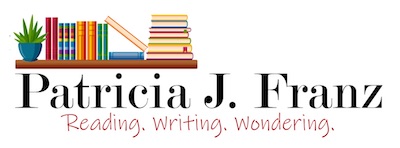AMERICAN CINQUAINS
 Am I the only person who thinks the kidlit TwitterVerse is – surprisingly NICE?
Am I the only person who thinks the kidlit TwitterVerse is – surprisingly NICE?
I jumped into Twitter a few years ago, and into the kidlit writing community specifically. As a listener-then-eventual-follower-then-eventual-Tweeter, I continue to find the writers, agents, editors, librarians, teachers, and publishers to be supportive, informative, and generous in their posts.
And the poetry shared on Twitter is a delight! I love the #haikuchallenge and #haikusaturday posts, especially when they are accompanied by pictures.
A couple months ago, I stumbled on @AlexPriceWriter. He bills himself as “Writer. Teacher. Procrastinator.” and claims credit for creating a daily #CinquainPrompt.
Several mornings a week, I find myself composing a simple cinquain on the Notes app on my phone — while sipping coffee and cradling a 50+ lb (and growing) Bernese Mountain puppy — from one of Alex’s daily challenges.
American Cinquain
The form of an American cinquain calls for five lines with two, four, six, eight, and two syllables in each successive line. There should be one, two, three, and four stresses for the first four lines, then one stress in the last line.
Undoubtedly, there are other cinquain forms. I’m but a dabbler; I have yet to explore the form in any depth. The important element of the explanation at left was: It did not intimidate me.
So I offer a few simple poems, coupled with what I am learning about how to use CANVA (thank you Janet Wong and Sylvia Vardell)!




Our Poetry Friday host this week is Dave at Leap of Dave who is “finding castles among ordinary things.”
He shares what so many of us have experienced in this incredible poetry-writing community: the inspiration from a fellow poet to jump in (Rose Cappelli, one of my poetry partners in The Nevermores)!

 Patricia Franz is a kidlit writer and published poet. She believes children, dogs, and sourdough have a lot to teach us about life, joy, and wonder. She has raised two boys, four dogs, and holds a master’s degree in Theology with a focus on children’s spirituality. Patricia, her husband, her Bernese Mountain dog, Bonny, and her sourdough starter split their time between the Arizona desert and the Sierra Nevada mountains.
Patricia Franz is a kidlit writer and published poet. She believes children, dogs, and sourdough have a lot to teach us about life, joy, and wonder. She has raised two boys, four dogs, and holds a master’s degree in Theology with a focus on children’s spirituality. Patricia, her husband, her Bernese Mountain dog, Bonny, and her sourdough starter split their time between the Arizona desert and the Sierra Nevada mountains. 
Patricia, your poem reminds me of summer walks at the nearby state park; it’s a great place to spot birds & butterflies. A virtual walk is a nice way to start the day. Thank you!
So glad I could be a part of your day, Susan!
oooooooooh! So, so, so pretty! Your post makes me want to write…but I have to go to work. sob.
I am in awe of you who work AND write! Thanks for taking the time to stop in and comment BEFORE work!
There is one swallowtail that does that “soft waltz in summer woods” here each year, Patricia. Love your creations, words & pictures!
Thank you, Linda. I am treated to an occasional waltzing butterfly – mostly I see my puppy zig-zagging after them!
Thanks for participating in Poetry Week this week. Know I’ve got cinquain in the membrane. And I’ve got to check out this kid lit twitter verse you speak of. Alas , the only thing I have time for this weekend besides the basics will be looking and commenting on all these amzing Poetry Friday posts.
Thank you for hosting, Dave!
Gorgeous poem and visuals! Thanks so much. We planted milkweeds and parsley for the butterfies this year, and have seen a few, but so hot and dry here. I think they are following the river.
What a treat! We don’t grow milkweed in the Sierras but I am treated to an occasional waltzing butterfly.
Your cinquains are beautiful, Patricia. And I love your Canva creations! I might have to find those haiku and cinquain challenges.
The challenges have been good for my morning exercises. Jump in!
Love the cinquains you wrote Patricia, especially the monarch one. I wrote two cinquains this week but submitted them somewhere, so I cannot share them yet. I love that you have a morning writing routine. Canva is great, isn’t it?! I learned to use it a couple of years ago when I took a writing-marketing course from author Amanda Zieba. You did some nice work! (I’m not participating in Poetry Friday this month, just wanted to pop in and read a few!)
Carol, thanks for stopping in. I’m late to reading everyone’s contributions this week, and my comments! So I understand!
I love Twitter, too, Patricia. Poetry is building a reputation on Twitter so I will follow whom you suggested. Maybe I shall join the Twitter challenges, too. I just need time to devote to poetry and reading. I started working on my swap for you but got distracted by the to-do list and our family trip. I will let you know when I am ready to send it off.
Take your time, Carol. I mailed a little something to you earlier this week. Enjoy!
“wonder on silken wings”
“meet me at midnight on the swings”
Your cinquains made me smile today, Patricia. Thanks for sharing your resources.
You are welcome, Denise! Jump in!
Lovely collection of cinquains Patricia, I really like your butterfly-wing-waltz and graphic, thanks!
Thank you, Michelle! Canva made it so fun and easy!